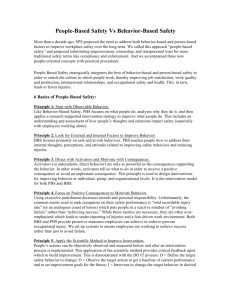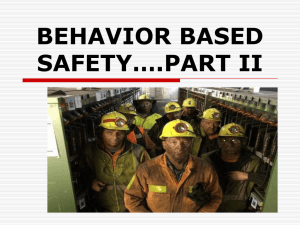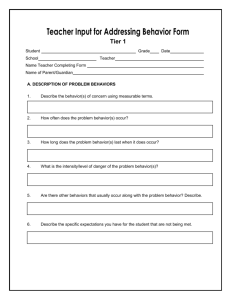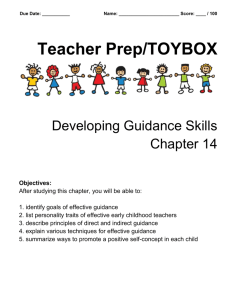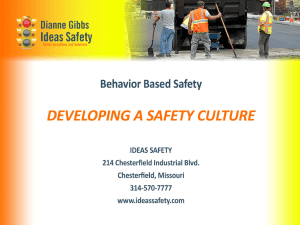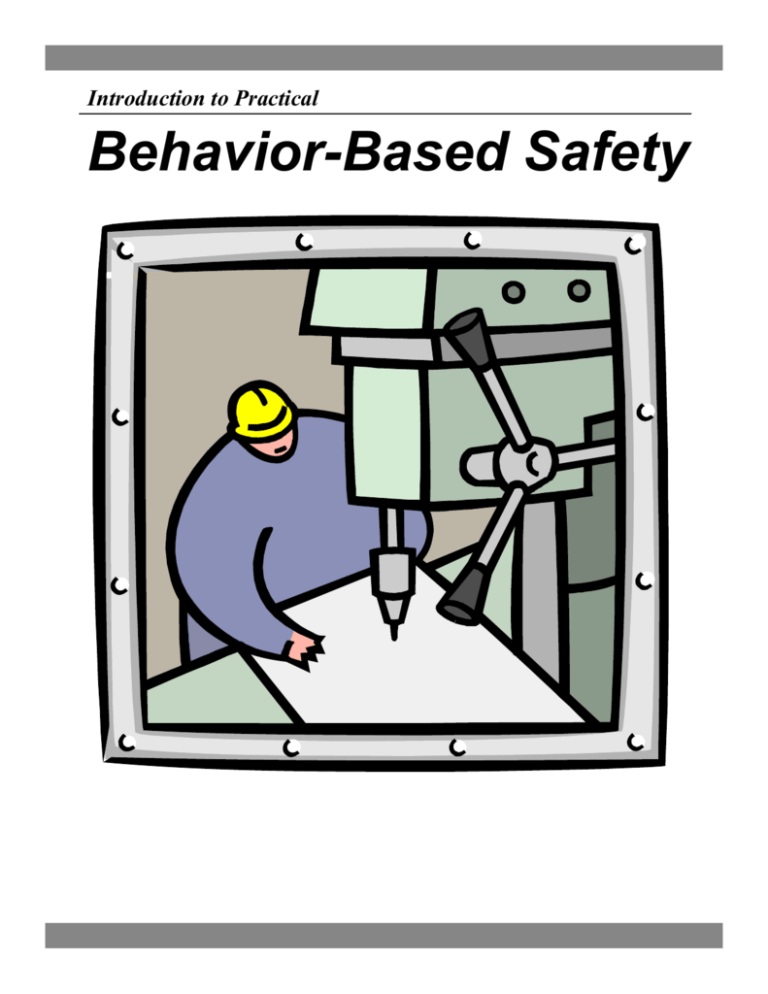
Introduction to Practical
Behavior-Based Safety
This material for education and training use only
Dan Petersen on behavior-based safety
“…as I look at what we, as safety practitioners, have done to the best concepts for possible
improvement, it seems we have done everything possible to make sure this (the behavior based
safety) approach will fade away -- just another “safety program of the month.” Maybe the answer
is to learn how to manage safety and health first, then implement these behavior-based
approaches.”
There is no universal agreement about behavior-based safety.
In a recent UAW article we read, “Most behavior based safety programs are fundamentally
outdated and erroneous theories repackaged for modern marketing. Salesmen for behavior based
safety programs claim to eliminate workplace injuries and improve relationships between
supervisors and workers. But often times, these safety programs set up elaborate mechanisms to
observe, coach, reward, and discipline workers. Behavior based safety programs appeal to many
companies because they make health and safety seem simple, do not require management change,
focus on workers, and seem cheaper than correcting hazards. The programs ignore the most
appropriate methods for eliminating health and safety hazards.” (On-the-Job Safety, Feb-Mar ‘99)
Could leadership-based safety be the key?
Behavior-based safety relies on trust between labor and management. Management and labor must
each earn that trust. Management is important, but without strong leadership, you can manage all
you want, but all you get is a nice set of safety manuals sitting on a shelf collecting dust. Labor is
important, but without leadership, all you get is a series of failed attempts at system improvement.
Leadership is key.
© OSTN 2000-2005.. All rights reserved.
This material, or any other material used to inform employers of compliance requirements of OSHA standards through simplification of the
regulations should not be considered a substitute for any provisions of the Occupational Safety and Health Act of 1970 or for any standards
issued by OSHA. The information in this publication is intended for training purposes only.
© OSTN Introduction to Behavior-Based Safety
2
This material for education and training use only
Business is Behavior
The ABC’s of BBS
Antecedents - According to Thomas Krause, antecedents are preexisting sensory or intellectual
input that trigger behaviors and influence decision-making.
• Tell us what to do to receive a consequence
• Can be tangible/concrete or intangible/abstract
• Only as powerful as the consequences that support them
Behavior - According to E. Scott Geller, behavior refers to acts or actions by individuals that
can be observed by others. In other words, behavior is what a person does or says, as opposed to
what he or she thinks, feels, or believes.
• A dead man can’t do it
• Must be observable, measurable
• Any time, any where, any body
Consequence - According to Aubrey Daniels, a consequence is simply what happens to the
performer as a result of the behavior. A consequence can be:
• Positive or negative. Does the consequence help or hurt from the performer’s point
of view?
• Immediate or future. When will the consequence occur?
• Certain or uncertain. What’s the probability that the performer will experience the
consequence?
Why do you work safely?
Antecedent(s)
Behavior
Consequence(s)
___________________________
___________________________
Put on my safety glasses
___________________________
___________________________
Which has the greatest influence on safe behaviors?
Activators
© OSTN Introduction to Behavior-Based Safety
Consequences
3
This material for education and training use only
Motivation Strategies: Behavior is a Function of Consequences
Every culture is a culture of consequences
Consequences that increase behavior
Positive reinforcement - To be effective, it must increase desired behavior. You work to get
something and may perform far beyond minimum standards. This is the only strategy that work to
increase discretionary effort. The focus is on success.
• Worker performs to receive the consequence
• Worker may perform far beyond minimum standards - discretionary effort
• The only strategy that works to increase discretionary effort
• Focus is on excellence - success based
• If you report a hazard, you are recognized.”
• “If you prevent an injury or save money, you are rewarded.”
Negative reinforcement - Intent is to increase desired behavior. You work to avoid
something you don’t want and usually perform only to minimum standards. This strategy may work
well if the focus is only on compliance.
• Worker performs to avoid the consequence - fear based
• Worker performs to minimum standard - just enough to get by
• Can work well if the focus is on compliance
• “If you wear that eye protection, you won’t get injured.”
• “If you comply with safety rules, you won’t be disciplined.”
Consequences that decrease behavior
Punishment - Intent is to stop undesired behavior. You get something you don’t want when you
misbehave. Punishment does not predict what the replacement behavior will be. It is usually
unintentional.
• You get something you don’t want when you misbehave.
• Does not predict what the replacement behavior will be.
• Is usually unintentional in organizations
• “If you engage in horseplay, you will be suspended from work.”
Extinction - Withdrawal of positive reinforcement. You work in a culture that ignores
performance. There is no relationship between performance and consequences. It is epidemic in
organizations. It doesn’t matter how hard you work.
• “Worker eventually performs without expectation of consequences (other than wages)
•
•
•
•
Person is ignored - no relationship with management
Is epidemic in organizations
“It doesn’t matter how hard I work around here.”
“Apathy is rampant, but who cares.”
© OSTN Introduction to Behavior-Based Safety
4
This material for education and training use only
To be effective, consequences should be…
Soon - occurs immediately after the behavior/performance.
“Thanks, but when did I do this?”
Does the BBS plan recognize performance immediately or as soon as possible?
•
The more time it takes to recognize, the more significant the recognition must be.
Sure- employees know (1) they will be recognized, and (2) why they’re being
recognized.
“Guess I was just lucky.”
Does the BBS plan specify precisely what must be done to get the award?
Do employees generally understand what’s required to get recognized?
When asked what it takes to earn the reward, do most reply with “I don’t really know”?
Does the BBS plan limit the number of rewards any one person can receive during a
given period? If the reward is always given to the “best” employee, the same person may
receive the reward most of the time.
Does the BBS plan allow a pass-around reward? When this occurs, the reward is not
contingent on behavior.
Significant - perceived as more than an entitlement. Significance is defined by the
receiver.
“We don’t have to recognize them…that’s what they get paid to do.”
Does the BBS plan assume that the same form of recognition is desired by all?
•
The receiver of a reward defines the nature (positive/negative) of the reward.
•
One employee’s reward might be another’s punishment.
Sincere - genuine appreciation or disapproval. You really mean it. Motives for
recognizing are not questioned.
“Recognize in public, reprimand in private!”… Any problems with this principle?
Is recognition given as a matter of policy or genuine appreciation?
Is the purpose of the recognition to make management, or the employee look good?
© OSTN Introduction to Behavior-Based Safety
5
This material for education and training use only
Micro Approach to BBS - Improvement is achieved primarily by
changing the behavior of the hourly employee.
Behavior-Based Safety refers to the use of applied behavior analysis models to achieve
continuous improvement in safety performance. In-depth research about what works and what
doesn’t. According to Krause, safety programs fail because they rely too much on antecedents -things that come before behavior -- safety rules, procedures, meetings, and so on.
Thomas Krause - BST ABC Steps in the Behavioral Safety Process
The Safety Improvement Process:
1. Identify critical problem behaviors. These become action items to work on.
2. Identify root causes. The “basic things” that need to be fixed to eliminate the problem.
3. Generate potential actions. Think of as many solutions as possible.
4. Evaluate possible actions. Choose those that are most productive.
5. Develop an action plan. To carry out the chosen solutions.
6. Implement an action plan. Carry it the change. Limit variables.
7. Conduct follow up. Problem solved? Measure and evaluate.
Dupont’s Safety Training Observation Program (STOP)
STOP for Supervisors. A comprehensive training program that teaches managers,
supervisors, and team leaders how to become more skilled observers of unsafe acts, to take action to
prevent their recurrence, and to encourage safe work practices.
STOP for Employees. Teaches employees how to observe and audit themselves to prevent
injuries and improve safety performance.
STOP Audits. Employee self-audits (independence) and observation and feedback to peers
(interdependence).
________________________________________________________________________________
________________________________________________________________________________
________________________________________________________________________________
People tend to become what the most important people in their lives think they will become.
© OSTN Introduction to Behavior-Based Safety
6
This material for education and training use only
Macro Approach - Permanent improvement is achieved through
cultural change
Michael Topf's (Topf Process)
1. Assess and analyze the culture. What belief systems are in place?
2. Educate and train to affect attitudes for line managers, supervisors, employees
3. Encourage structured involvement of all employees in problem identification and problem
solving
4. Reinforce key concepts. Awareness, responsibility, self-observation, self-management.
5. Provide ongoing support and commitment
6. Observe behaviors and provide feedback. Tailored to specific needs of the workplace.
Apply strategy to all organizational levels
1. Self Level - Personal responsibilities/accountabilities. Self attitudes/behaviors
2. Peer Level - Peer interaction and support for safe attitudes/behaviors
3. Leader Level - Consistent safety commitment/communications/messages
4. Organizational Level - Culture with values, commitment and behaviors that reflect clear
vision.
Focus on process measures, not results measures
According to Michael Topf, “In many organizations, an over-reliance on safety-related OSHA
statistics obscures the importance of more fundamental culture change methods.
“Given the importance OSHA places on record keeping, such outcome statistics cannot of course be
ignored in assessing progress toward a safer workplace. But the focus of statistics and measurement
needs to be on process measures, such as changes in attitudes, values, and behaviors that directly
influence OSHA measureables. Similarly, programs and incentives need to be based on what people
think and do, measures not easily captured on the OSHA 200 log.”
© OSTN Introduction to Behavior-Based Safety
7
This material for education and training use only
According to Michael D. Topf, there are nine common obstacles to cultural change:
1. Management has assumed responsibility for safety and supervisors play the role of “safety
cops.” Safety in such workplaces is perceived as a negative.
2. The safety message is not getting out because downsizing has reduced the number of
individuals available to communicate it. Meanwhile, production demands are on the rise
increasing pressure to cut corners.
3. The press of meetings and other administrative tasks means less time for supervisors to spend
on safety training and reinforcement.
4. Supervisors are often poor role models, taking shortcuts themselves and failing to follow
company and OSHA rules.
5. Supervisors ask employees to take risks, either implicitly or explicitly.
6. Supervisors condone or overlook risk-taking behavior until an injury occurs, and then they
counter it with discipline.
7. Line employees hold on to tenacious, counterproductive beliefs such as: “Accidents don’t
happen to me.”
8. There is a lack of trust between labor and management; unresolved conflicts erode trust and
communication.
9. Fear of job loss is prevalent and negatively impacts morale and job performance.
Each of these nine obstacles, once accepted by a majority of the organization, becomes part of the
collection of beliefs and day to day behaviors that constitutes the organization’s culture.
Core beliefs that influence culture on the personal and organizational level.
• All injuries are preventable.
• All employees are responsible for their safety and the safety of their co-workers
• Management is ultimately responsible for the safety of all employees.
• Working safely is a condition of employment.
• All risks will be identified, addressed, and managed.
• Educating and training employees to work safely is essential.
• Preventing injuries is good business - a profit center activity.
• Safety, production, cost, and quality depend on each other.
• Safety will never be compromised for production or convenience.
• Every employee has the obligation to shut down an unsafe operation.
• The continuing health and wellness of each employee is vital to our long-term success.
© OSTN Introduction to Behavior-Based Safety
8
This material for education and training use only
Integrated approach - Culture and individual behavior are both
important components and reflect “active caring”
E. Scott Geller: Safety Performance Solutions (SPS) - Total Safety Culture
An “actively caring” Total Safety Culture requires continual attention in three domains.
External Environmental Factors
iro
nm
Pe
r
v
En
Knowledge, skills, abilities,
intelligence, motives,
personality, attitude
so
n
Internal Personal Factors
Equipment, tools, machinery
housekeeping, temperature,
engineering, standards
Operating procedures, rules
t
en
Behavior
Behavior Factors
Complying, reporting, coaching,
recognizing, communicating, actively caring
Geller’s Do-It Process
Define critical behavior(s) to increase or decrease
Observe target observable behaviors during the pre-intervention phase to determine baselines,
set goals, understand influences on target behaviors.
Intervene to change the target behavior(s) in desired directions.
Test the impact of the intervention procedures by continuing to observe and record the target
behavior(s) during the intervention program.
________________________________________________________________
________________________________________________________________
________________________________________________________________
________________________________________________________________
© OSTN Introduction to Behavior-Based Safety
9
This material for education and training use only
Geller’s Seven Principles that Define Behavior-Based Safety
1. Focus interventions on observable behaviors.
• Why? You can be objective about behaviors.
• Address it independently from attitudes, opinions.
2. Look for external (system) factors to both understand and improve behaviors.
• Easier to define and correct, objectively, change directly. Independent of feelings.
3. Direct behavior with activators (antecedents) and motivate behavior with
consequences.
• Activators tell us what to do…Consequences are what we get out of it.
• Activators are only as powerful as the consequences supporting them.
4. Focus on positive consequences to motivate behavior.
• It results in behavior beyond compliance, increases frequency of desired behaviors,
improves morale.
5. Apply the scientific method to improve interventions.
• Rather than “common sense,” or intuition, which is based on selective listening and
interpretation, and is usually biased.
6. Use theory to integrate information but not to limit possibilities.
• Don’t design to answer the question, “What will happen if we do this?”
• Rather, answer the question, “Is my theory correct?”
7. Design interventions with consideration of internal feelings and attitudes.
• Intervene to increase feelings of control, accomplishment, personal freedom.
• The employee works to achieve pleasant consequences, not to avoid unpleasant
consequences.
© OSTN Introduction to Behavior-Based Safety
10
This material for education and training use only
Dan Petersen’s Three Basic Strategies to Influence Behavior
1. To change attitudes in the belief that our behavior is consistent with our attitudes.
How can you accurately determine an attitude?
________________________________________________________________________
_________________________________________________________________________
2. To build a psychological climate in which people will choose to behave as we wish, since that
behavior helps to satisfy their current needs (We call this motivation).
What’s the difference between a tough controlling culture and a tough
caring culture?
_________________________________________________________________________
_________________________________________________________________________
3. To modify behavior through the systematic use of reinforcement following behavior to influence
future behavior.
What are the behaviors we want to modify?
_________________________________________________________________________
_________________________________________________________________________
Traditional program-oriented safety management
•
Relies primarily on Strategy #1. Emphasis on antecedents to influence behavior
•
Motivation - avoid negative consequences.
•
Occasional negative reinforcement - discipline and loss of rewards.
Contemporary behavior-based safety management
•
Relies primarily on Strategies #2 and #3. Emphasis on consequences to influence behavior.
Does not attempt to measure (but does not ignore) attitudes because it’s very complex.
•
Motivation. Receive positive consequences
•
Frequent positive reinforcement - frequent recognition and Occasional reward.
© OSTN Introduction to Behavior-Based Safety
11
This material for education and training use only
What Behavioral-Based Safety does not do…
9 Does not turn safety over to any one level of the organization. It does not shift
responsibility or accountability away from management to the employee.
Why is it dangerous to promote the idea that “our employees own the safety
program”?
________________________________________________________________________
________________________________________________________________________
9 No relief from the basic truth that safety is line management's responsibility.
Management still has legal responsibility for safety.
Why does OSHA Law hold the employer accountable…not the employee?
________________________________________________________________________
________________________________________________________________________
9 Not a quick fix. The underlying system weaknesses must be improved.
Why does OSHA conduct accident investigations? Why should employers not
investigate…but rather analyze incidents and accidents?
________________________________________________________________________
________________________________________________________________________
© OSTN Introduction to Behavior-Based Safety
12
This material for education and training use only
What it takes to succeed: Dan Petersen
Dan Petersen states that…”one of the fundamental tenets of safety is that safety systems can look
like almost any thing, as long as these systems meets two key criteria.
Two key criteria:
1. There is a system of accountability in place that defines roles, ensures knowledge to
fulfill the roles at each and every level from worker to CEO, measures role fulfillment; and
has rewards contingent upon role fulfillment.
2. The system asks for, allows for, requires, and ensures participation at each level.
BBS is not BS...What does it take to work?
Behavior-based safety must…
1. Define critical behaviors at each level of the organization - bottom to top.
________________________________________________________________________
________________________________________________________________________
2. Ensure each person clearly understands required behaviors
________________________________________________________________________
________________________________________________________________________
3. Accurately identify and measure the presence of behaviors
________________________________________________________________________
________________________________________________________________________
4. Reinforce appropriate behavior with soon, certain, significant, and sincere
recognition.
________________________________________________________________________
________________________________________________________________________
© OSTN Introduction to Behavior-Based Safety
13
This material for education and training use only
Elements of a Behavior-Based Safety System
1. Formal standards for behavior and performance
• Vision, mission, values, priorities
• Policies, Plans, Processes, Procedures, Practices
• Clearly communicated and understood by all
2. Resources to meet/exceed standards
• Physical = tools, equipment, materials, workstations, facilities
• Psychosocial = workload, time, education, training, scheduling, culture, leadership, trust
3. A system of measurement
• Measurement = Observation + quantification
• Criteria. Performance evaluated against established criteria.
• Formal observation and feedback
4. Effective consequences
• Soon - Certain - Significant - Sincere
• Must increase desired behaviors.
5. Appropriate application
• Selection criteria. How are employees selected for recognition and reward?
• Presentation. How is recognition presented? Who what where how when?
• Fairness. Consistently applied laterally, vertically
6. Continual evaluation of the system
•
•
•
•
The recognition system is married to the accountability system
Analysis/evaluation headed up by Safety committee?
Improvements designed by safety coordinator?
Improvements implemented by line management?
Not
Not knowing
knowing why
why things
things get
get better
better or
or worse
worse isis always
always aa problem
problem for
for aa business.
business. IfIf itit gets
gets better
better “for
“for no
no reason,”
reason,” later
later itit will
will
probably
get
worse
“for
no
reason.”
…The
point
is,
it’s
not
enough
to
know
that
something
works.
It
is
vitally
important
probably get worse “for no reason.” …The point is, it’s not enough to know that something works. It is vitally important to
to
know
know why
why itit works.
works. (Aubrey
(AubreyDaniels,
Daniels,Bringing
BringingOut
OutThe
TheBest
Bestin
inPeople,
People,p.
p.14)
14)
© OSTN Introduction to Behavior-Based Safety
14


